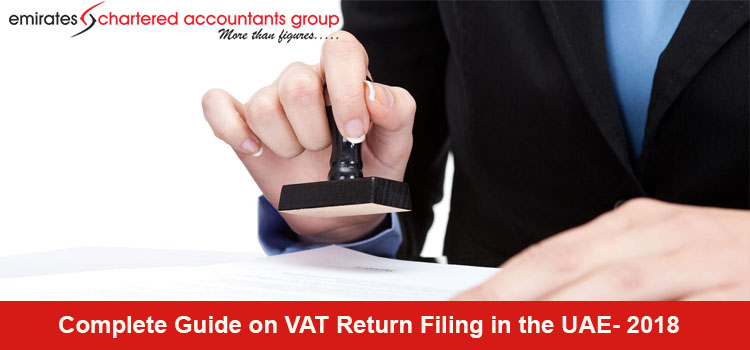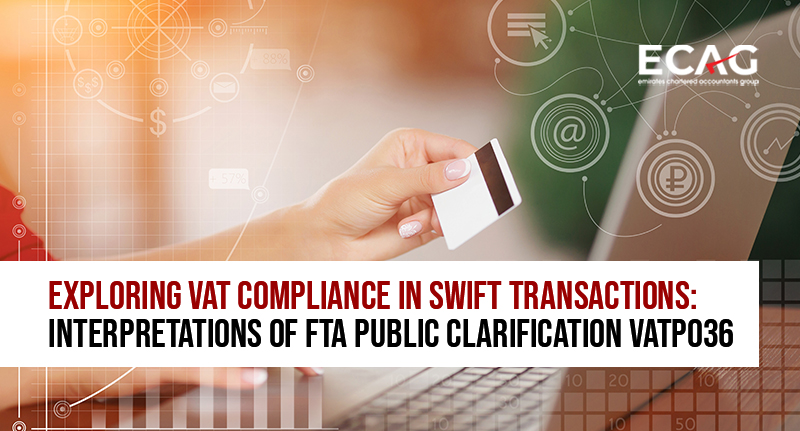
What does VAT return filing mean?
VAT Return filing is the official tax document to be submitted to the Federal Tax Authority before the due date. VAT Return filing has to be done by the Taxable Person at regular intervals depends upon his tax period. The VAT Return should show the details of any output tax due and input tax recoverable together with other information as required by the format. It can be filed either by a taxable person or any other person who has been authorized to do so on behalf of the Taxable Person (a Tax Agent or a Legal Representative).
Where to find the VAT return format?
Federal Tax Authority has published the VAT Return Format in their web site “VAT201- VAT Return”. In order to access it, you have to log in to the FTA e-services portal using your registered username and password. Currently, it is available only to those Taxable Persons who are required to file their return for the month January 2018 (due date 28th February 2018).
When should you account for VAT return filing as per FTA?
VAT Return Filing must be done by not later than 28th day of the month following the Tax period or by such other date as requested by FTA. For example; if your first VAT return period is January 2018 to March 2018, your VAT return due date will be 28th April 2018. Where a payment is due, it should also be paid by the same deadline. Where the due date falls on a weekend or a national holiday, the deadline is extended to the first business day thereafter. Late filing of VAT return attracts penalty of AED 1,000 for the first time of occurrence of a delay. The penalty would be increased for subsequent non-compliance of filing of VAT Return.
The standard Tax period applicable to a Taxable Person is a period of three calendar months. However, FTA has assigned different Tax Periods for a certain group of Taxable Persons. Some of them have Tax Period on monthly basis. A Taxable Person has an option to request to the FTA to change his Tax Period. However, it is at the FTA’s discretion to accept the request.
What needs to be taken care of while filing your VAT return?
While doing the VAT Return filing process, details of the Taxable Person will be pre-populated. Further, details like the current VAT Return Period, Tax year-end, VAT/Tax Period reference number and VAT Return submission due date will also be generated automatically. For VAT Return Filing, the following should be taken care of;
- All amount should be in United Arab Emirates Dirhams (AED).
- All amounts should be rounded off to the nearest fills.
- All mandatory fields should be completed.
- Use “0” if there are no amounts to be declared.
The VAT Return Filing requires every registrant to provide emirates wise details of taxable supplies i.e. based on the fixed establishment (head office/branch/warehouse etc.) from where supplies are happening. Details to be summarized under Taxable Supplies includes the following;
- Supply of goods and services (net of discount).
- Sale of commercial Property
- Advances received.
- Deposits received other than those which are refundable (e.g- security deposit)
- Goods sold under the Profit Margin Scheme.
- Supplies of Goods within Designated Zone which are consumed within Designated Zone
- Supplies made by a non-resident who had to register in UAE since the recipient of goods or services is not registered in UAE (and hence Reverse Charge Mechanism does not apply).
- Credit notes issued (to be deducted from total supplies).
- Errors noted for the Previous Tax periods can be deducted provided the error does not result in the Output Tax being increased/decreased by an amount more than AED 10,000/.
Notes:
- Value of supplies should be net figure i.e. excluding the VAT charged to the customer, which is to be included in the next column.
- In the case of goods sold under the Profit Margin Scheme, the full value of such supplies should be reduced by the value of VAT calculated on the margin.
- Adjustment column shown on the VAT return should only be used to adjust the TAX due relating to the following;
- VAT Bad Debt Relief
- Sales of taxable commercial property in the UAE where tax is paid by the customer.
- In case of errors (noted for previous Tax Periods) which result in the Output Tax being increased/decreased by an amount in excess of AED 10,000/- self-declaration is required to be made by the registrant separately and hence the same cannot be included for the VAT Return Filing.
Retailers who have provided a refund to tourists under the official tourist refund scheme are required to provide the details regarding the same in the VAT Return Filing. The value of supplies of goods and services under the Reverse Charge Mechanism is to be declared separately. However, the value of goods imported into UAE will be auto-populated to the extend it was declared under the Taxable Person’s customs registration number.
Adjustments can be made to the value of imported goods that is auto-populated in case of omission or mistake in the value when compared with the amounts reported in the customs and import declaration. Further, any import of goods which are not subject to the standard rate of VAT in the UAE at 5% can also be adjusted as by default all the imports are assumed to be subject to 5% VAT rate. Additional information relating to supply to be declared in the VAT Return Filing are the Zero-rated supplies and exempted supplies. The details of standard-rated expenses to be declared in the VAT Return includes the following;
- Goods or services purchased (net of discount).
- Goods or services purchased before Tax Registration for which input Tax can be claimed.
- Credit notes raised by the supplier.
- Errors noted for the Previous Tax periods can be deducted provided the error does not result in the Output Tax being increased/decreased by an amount more than AED 10,000/.
Notes:
- Total net value of the standard rated expenses on which you are seeking to recover VAT should be included while declaring the standard rated expenses.
- The VAT column should include only those amounts which you are entitled to recover.
- Adjustment column to be used to adjust the Tax amount for the following;
- VAT Bad Debt Relief
- Input Tax apportionment annual adjustments
- Capital Asset Scheme adjustments
- In case of errors where self-declaration is required as mentioned above, the same procedure should be followed.
After filling the details in the VAT Return Form, the net amount payable will be automatically calculated. In the case where the payable value is negative, you can have two options - To get a refund or to carry forward the amount to the next tax period. VAT shall be paid through an e-Dirham payment gateway which supports payments through an e-Dirham card or a credit card (Visa and Master cards only).
Our Tax professionals at Emirates Chartered Accountants Group provides the best VAT Return Filing Services in the UAE by visiting your office on a periodical basis to compile for your VAT Return Filing. We offer Complete assistance for guidance and support of VAT Return in accordance with the provisions of UAE VAT law.
Looking for TAX Services in the UAE?
We provide:
- Tax Agent’s Service
- VAT Return Filing
- VAT Service
- VAT Registration
- Excise Tax Service
- VAT Deregistration
For Tax Services in Dubai:
Mr. Pradeep Sai
sai@emiratesca.com
+971 – 556530001
For Tax Services in Abu Dhabi:
Mr. Vinay. E. R
vinay@emiratesca.com
+971 54 378 44140
For Tax Services in Northern Emirate (Sharjah, Ajman, RAK, Fujairah)
Mr. Praveen
praveen@emiratesca.com
+971 – 508873115





